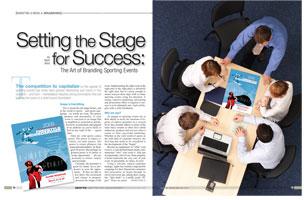
The competition to capitalize on the appeal of sporting events has never been greater. Marketing your event in this lucrative - and loud - marketplace requires strong promotions that are built on the back of a solid brand foundation.
Image is Everything
You're heard the old adage before, and in the world of sports - and sports marketing - no words are truer. The power, purpose and personality of your event is conveyed in an image that is amplified to, projected to and dissected by as passionate and targeted of an audience as you're likely to find in any walk of life: sports fans.
 After all, with sports comes power. The power to induce rivalries, yet unite masses. The power to create alliances, but transcend nationalities. In short, sport IS power. But perhaps its greatest power is its ability to create opportunity: the opportunity to attract, inspire and persuade.
After all, with sports comes power. The power to induce rivalries, yet unite masses. The power to create alliances, but transcend nationalities. In short, sport IS power. But perhaps its greatest power is its ability to create opportunity: the opportunity to attract, inspire and persuade.
Certainly, the potential is great for smart, savvy promoters to seize the opportunity - IF they are able to rise above the excitement and clamor to properly promote the image of the event. Implementing the right event at the right time in the right place is definitely the right start, but it's rarely enough to ensure success these days with so many sporting events vying for attention. A strong, cohesive marketing, advertising and promotions effort is required if success is to be ultimately met. And it all begins with a solid foundation.
Who are you?
As unique as sporting events are in their ability to incite the emotions of legions of captive spectators at a visceral level, they actually adhere to many of the same basic tenants as other (less rabid) endeavors, products and services when it comes to their successful marketing. Whether in the wild world of sports or the mild land of corporate America, the first step that needs to be considered is the development of the "brand."
Beyond an explanation of "what" your event is, a well-defined brand clearly communicates "who" your event is. And, just as importantly, who it's not. Done properly, a brand represents the very core of your event: its personality, its values, its style.
Using a relevant, topical corporate analogy, Apple has created a high profile campaign for their Macintosh computers that personifies its brand through its clever television ads, pitting their young, hip "Mac dude" vs. a stuffy, nerdy "PC guy." These are great ads that are very well executed (and, of course, have tons of media dollars to support them), but the basic premise is as old as the art of advertising itself and creates the perfect metaphor for the power of brand building: if you think of your event as a person, you can better communicate the truths of "who" you are and better align your event with your desired audience.
These "truths" are what people will ultimately connect with as you start your promotions. Prospects need to make a connection - both rationale and emotional - in order to do business with you. Just as you might not do business with a person whom you don't like, the "personality" of a brand can greatly affect overall interest in your event, be it from sponsors or spectators. As such, the importance of brand cannot be overstated. But first, it must be understood.
The Truth About Brand
The concept of brand is at once universally recognized and globally misunderstood. There are three basic characters at play in brand building: brand image, brand identity and brand strategy. Brand image is something that is, through association, attributed to all entities, organizations, companies and products. Contrary to its popular interpretation, brand image is NOT something that is created by the brand owners. Rather, it's a collection of perceptions in the minds of consumers, and it exists…whether we like what it says about us or not. Brand image, as such cannot be completely controlled. But it CAN be shaped.
Brand identity, on the other hand, is the desired perception of the brand. It is how we want target audiences to view our brand - in this case, a sporting event - and the benefits we expect to receive from it (sponsorship opportunities, event awareness, boosted ticket sales, etc.). Brand identity, then, is the public persona that the brand exudes; it aligns your organization and/or event by clearly defining common goals and aspirations.
 There is something very important to learn, here, beyond the semantics at play. And that's where brand strategy enters the equation. You see, the key for organizers - as they slip their all-important branding hats on - is to move from Point A (brand image) to Point B (brand identity.) As you might have guessed, this is achieved through brand strategy and positioning. In its simplest explanation, brand strategy is the collection of common vision, themes, messages and images executed at all desired consumer touch points. A cohesive brand strategy results in an identity that is appropriate to the organization, can be delivered upon, and is controlled by the organization. It carries the "promise" to the marketplace that your event has certain qualities or characteristics that make it special or unique (i.e. differentiated). Whatever the mix of programs used to promote the event, branding techniques should be consistent and complementary when well executed. Let's take a look at how this is accomplished.
There is something very important to learn, here, beyond the semantics at play. And that's where brand strategy enters the equation. You see, the key for organizers - as they slip their all-important branding hats on - is to move from Point A (brand image) to Point B (brand identity.) As you might have guessed, this is achieved through brand strategy and positioning. In its simplest explanation, brand strategy is the collection of common vision, themes, messages and images executed at all desired consumer touch points. A cohesive brand strategy results in an identity that is appropriate to the organization, can be delivered upon, and is controlled by the organization. It carries the "promise" to the marketplace that your event has certain qualities or characteristics that make it special or unique (i.e. differentiated). Whatever the mix of programs used to promote the event, branding techniques should be consistent and complementary when well executed. Let's take a look at how this is accomplished.
Setting the standard
As you design your event, you do so with knowledge of what makes it unique in the marketplace. Within the context of a face-to-face meeting with prospective partners and stakeholders, these attributes are most likely easy for you to convey. This becomes more of a challenge as your audience expands in breadth and depth to include a larger segment of people important to the success of your event. The key is to define the characteristics of your brand concisely and completely, and then build a stage from which your brand communicates these strengths clearly to all who will listen.
Branding professionals and consultants call this stage the brand platform, and it should become the road map for all the marketing and communication efforts taken on your brand's behalf. Developing this platform is easy in concept, but can be difficult in execution. This is where you have to make definitive decisions on "who" your brand is and "who" it is not and then weigh the importance of each of these attributes which will become the pillars of your brand building efforts. There's no room to vacillate on this exercise; you must squelch the inherent desire to be all things to all people. Your audience deserves to know to whom, exactly, they decide to emotionally and rationally attach themselves (and their dollars) and they will appreciate your candor and decisiveness in this regard.
Brand platforms vary from organization to organization, but as a rule they should include some or all of the following: brand story, mission, vision, values, value proposition, personality, style, tone of voice, key messages, and a singular brand statement. Though a brand platform may be developed internally, a marketing partner can greatly aid in this process.
What should then fall out of this document is a brand standards manual, usually produced by your graphics marketing partner, that will serve as the official guideline for all communications and will be a resource for all parties (internal and external) who have a hand in creating the advertising and marketing materials used to promote your event. A well-developed brand standards manual may identity the treatments and standards for: typography, color palettes, photographic assets, layout and grid structure standards and styles for use, and language guidelines.
If you build it (correctly), they will come
Building your brand is a powerful early step in allowing the success of your event. Consistency of messaging is key to any successful marketing campaign. It avoids confusion and strongly communicates the essence of your brand. By clearly defining "who" your event is, building an appropriate and solid foundation for its communications, and executing your promotions consistently and cohesively, you provide the perfect arena for its success.

